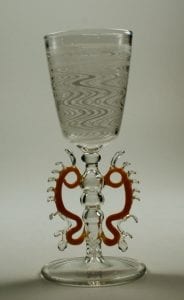Cristallo glass: Venetian sash glass - German/German

From the 13th to the 18th century, Venice was the leading glassmaking centre in Europe. On the one hand, the new crystal-clear glass mass was responsible for this. The Venetian glassmakers called it "cristallo" glass because of its similarity to rock crystal. Secondly, it was the new shape of the drinking glass. Now they were no longer drinking cups like the medieval green forest glass. With refined elegance, goblets and winged glasses were produced with a strict separation of the form into foot, stem and drinking goblet or dome. They were made in filigree or, if in white, then in latticino technique - from the Italian "latte" - milk. The thread glasses produced in this way led to the first flowering of Venetian glassmaking at the beginning of the 16th century. As "glass à la facon de Venise", they ushered in the triumphal march of Venetian glass.
The white glass threads of the dome were drawn from thick glass batches in a hot state over 20 metres long. Heated again, they were placed as threads on the dome and fused together. The stem of the glass, designed as a "wing", was particularly popular. For this, coloured glass threads were freely formed, curved and the prongs pinched into the hot glass mass. Museum glassblower Ralf Marlok masters this elaborate technique on his gas burner. On request, he can produce such "Venetian winged glasses" according to the original in the glass museum.
Cristallo-Glass: Façon de Venise - English

From the 13th to the 18th century Venice was the leading glassmakers' centre in Europe. One of the reasons for this was the new crystal-clear glass mass, which Venetian glass makers called "cristallo"-glass, because of its similarity to quartz crystal. The other was a new shape of drinking glass. We're no longer talking about green glass beakers from the Middle Ages here, we're talking about elegant chalice - shaped and winged glasses with a strict separation in the shape of the foot, stem and drinking chalice, or cupa. They were produced in filigree, or if in white, in Latticino technique, which is derived from the Italian word "latte" for milk. These so-called "thread," glasses led to the blossoming of Venetian glassmaking art at the beginning of the 16th century and the Venetians introduced this glass triumph as "Glas à la facon de Venise.
The white glass threads of the cupa were made of thick glass rods, which were stretched in a molten state to over 20 m long. Reheated, the threads were then later laid on the cupa and smelted. The wing- design stem of the glass was very popular and was created with coloured glass threads that were formed and curved by hand and the points were pinched into the molten glass. Our museum glassblower, Ralf Marlok has also mastered this very intricate technique using his blowtorch and he is more than happy to make you some Venetian winged glasses based on the original you see here in the museum.